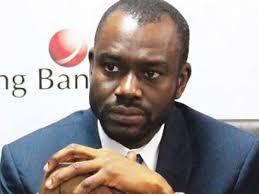STERLING BANK: On The Treadmill For Long

Is the management of Sterling Bank Plc led by its Chief Executive Officer, CEO, Abubakar Suleiman, still in control of its future or asleep at the switch?
This is just one of the questions perturbing both existing and potentials investors of this bank .This question may not be farfetched. Shareholders are one butarguably the most important of the five major constituencies any bank serves . Every bank is expected to satisfy them by providing maximum or adequate return on their investments in order for them to remain invested in the bank and to be willing to continue to provide additional resources as and when needed. However, Sterling bank’s weak fundamentals have kept its stock under performing for long just its dividend yields have been miserable . The current share price of Sterling Bank is NGN 1.89. The STERLNBANK stock closed its last trading day (Wednesday, December 9, 2020) at 1.89 NGN per share on the Nigerian Stock Exchange, recording a 1.56% drop from its previous closing price of 1.92 NGN. STERLNBANK began the year with a share price of 1.99 NGN but has since lost 5.03% off that price valuation, ranking it 107th on the NSE in terms of year-to-date performance. Shareholders’ worries are further compounded by the fact that STERLNBANK has lost 14.09% of the stock’s value from November 11 to date.
.
The bank’s stock epitomizes traits of a laggard in the Nigerian Stock market. Moreover, one thing that raises concerns around the brand is the endless hopelessness surrounding the management’s ability to turn it around for better returns . How long will this brand stay on treadmill trying to keep one step ahead of the steadily declining margins and profits of yesterday businesses? The is the puzzle around this brand.
In the past three months, its share price swings up and down like spirit more frequently than three quarters of the entire stocks in the market. The share price of Sterling Bank Plc is low while its inability to lift to any appreciable levelXxxxxwhichXXXX is neither good for the bank nor for its investors is another negative high point that put off investors . Asides its little potential for capital gains, the greater tragedy is that it rarely pays dividends and when it pays it isxxxx a Xxx miserable amount . This is the agony of its investors. Although price volatility is a natural phenomenon in equity trading ,however, too much of it signals greater risk .
.Low returns and earnings power as well as its high level of non cash earnings, its usual trademarks, continue to give its investors sleepless nights. As indicated above , one of the traits that put off investors is its high level of non cash earnings, as its reported profit usually are not backed up by cash . Moreover, according to the latest share price analytical reports , the bank is more volatile than 75 percent of the entire stocks over the past three months .Although, its weekly volatility at 10 percent by standard deviation has been stable in the past year ,it is still higher than 75 percent of the entire stocks in the market ; that makes it more risky . Its 1.5 percent negative return under performed both the industry and the market at 12percent and 22.4 percent returns respectively over the past year ; at its 3.7 percent return per year in the past five years return equally under performed the industry at 35percent . Its unimpressive performance, may be linked to poor price earnings ratio [ 5.4x] which is believed to be high relative to its earnings compared to the industry’s price earnings ratio [ 3.4x ]. Although ,the bank is good value compared to the market with a PE of 8.3x , the bank share , however , is selling at a discount to its book value at 0.4x .
Sterling Bank’s current net profit margins of 12.9 percent is quite miserable and one of the factors that distracts investors attention from its stock and keeps its price low and volatile .Moreover, its Return on Equity at 8.2 percent and Return on Assets ,ROA 0.8 are both abysmally low to attract investors good attention and drive its stock price impressively .Return on average equity (post-tax) declined to 8.8% in H1 2020 from 11% recorded in H1 2019. The highest return on average equity of 12.5% was recorded in H1 2015 while the lowest return on average equity of 8.5% was recorded in H1 2017 Return on average assets (post-tax) declined to 0.9% in H1 2020 from 1.1% recorded in H1 2019. The highest return on average assets of 1.5% was recorded in H1 2015 while its lowest return on average assets of 0.9% was recorded in H1 2020
Sterling Bank’s stock traded on Monday, November 30, 2020 at 1.94 NGN per share on the Nigerian Stock Exchange . It began the year with a share price of N1.99 but has since lost 2.51% off that price valuation, ranking it 106th on the NSE in terms of year-to-date performance. At 1.94, it is -26.79% below its 52-week high of 2.65, set on Nov 13, 2020.. The following trading day ,December,01, 2020, its share price collapsed again to N1.90k or 0.04 percent .
At that price its one day return was 2.06 percent down and its one year return was 7.32 percent down . With outstanding shares of well over 28,790 billion , Sterling Bank’s Earning Per Share in 2019 was N0.38 while its Price Earning Ratio was 2.85. Its dividend yield, was 1.98 percent ; its dividend per share at 3k in 2019 amounted to 8 percent dividend payout .And in 2018 ,its dividend was 2k . In 2017 ,the bank declared a dividend of 2 kobo for every share of 50 kobo .The bank’s dividend nosedived since 2015 . That year pay the bank paid 9k dividend per share ., MrAdeola , the then CEO of the bank , said the bank was driven by the need to save more to boost the shareholder funds capacity and also regain more capital considering the regulatory requirement on capital adequacy, under the Basel II and III accords.
.
The above less impressive runs leave investors wit little or no capital gains or dividend .The weakling pace of the bank stock, as is the case with most quoted stocks, is indicative of a market wide apathy for capital market assets. It is also a pointer to the fact that the economy is depressed and the propensity to save (which approximates the propensity to save), is rather weak. . But more than any other factor, it is an indication that Investors are not too impressed with the bank’s showing in the past few years with unimpressive earning power and valuation .
9 Months , 2020 : HEAD HARDLY ABOVE THE WATER
The ongoing financial year 2020 ,without any doubt, is stormy .The COVID-19 pandemic put a lot of pressure on Nigeria’s banking sector in both Q2 and Q3 2020, with the sector shrugging off its lethargy in Q3 as the economy restarted after three months of partial lock down imposed by the federal and state governments which led to restrictions in business activities and movement.
However, for Sterling Bank Plc , the impacts made it difficult that it barely raised its head above the water level.
Despite the modest growth in Net Interest Income, in the first quarter, 2020, its pre-tax profit declined significantly, down 32% y/y to N2.2bn in Q1 2020, due to weaker Net Fee and Commission Income (-16% y/y) and weak operating efficiency, given the increase in OPEX (up 8% y/y) compared to the increase in Operating Income (up 3% y/y).
Q2,2020
In the first half year, regulatory mandates also directly worsened commercial bank’s ability to generate substantial non-interest income (fees and commission) in the short run. CBN’s new bank charges which took off on January 1, 2020, saw card maintenance fees and electronic transfer fees reviewed downwards.
The above policy in the case of Sterling Bank, the impact was mammoth, evidenced in the disparity between the N4.1billion derived in Q2 of 2019 and N2.4 billion obtained in Q2 of 2020. The spirit of these legislations are to ensure a more structured and stronger institution, but their negative impacts on cash flow for these commercial banks cannot be overplayed.Sterling Bank made N5.4 billion in profit for the Half-year 2020. This falls shy of the N5.7 billion posted in the corresponding period of 2019.
Sterling bank recorded a significant increase in its impairment charges in H1 2020, impairment charges increased by +165.8% from N2.43bn recorded in H1 2019 to N6.46bn recorded in H1 2020. The Group also recorded a significant increase in impairment charges in Q2 2020, from N1.19bn recorded in Q1 2020 to N5.27bn recorded in Q2 2020.
The cost-to-income ratio (CIR) declined to 72.6% in H1 2020 from 80.3% recorded in H1 2019, this was driven by a marginal Y-o-Y decline in operating expense of and a -0.11% Y-o-Y increase in +9.04% operating income. The decline recorded in operating expense was achieved despite growth in expenses of the Group including AMCON and insurance fees.This cost to income ratio is still high among the worst in the industry
Q3,2020
In the third quarter 2020 ,its gross earnings declined marginally .Sterling Bank Plc reported gross earnings of N106 .07 billion in 2020 9M compared to N109.66 billion same period in 2019 – a decline of 3.28%. while its profit before tax climbed by 4.9 percent to N8billion from N7.7billion .But its post tax profit backtracked .
But the bank’s Chief Executive Officer, CEO, Abubakar Suleiman, was still enthusiastic. “Our performance reflects the positive results of strategic decisions and investments in our focus areas as we continued to record significant improvement in both funding and operational costs. Overall, we delivered a 7.2% increase in operating income and a profit after tax of N7.37 billion despite prevailing uncertainties around the COVID-19 pandemic ,he declared ”
Why was the bank’s Chief Executive Officer, beating his chest as though the bank was Covid 19 proof ; the bank still suffered its injury at the bottom line ; while its pre tax took a leap ,its net profit could not survive it as it ended up in negative outlook. Its net profit could not escape the scalpel. It was down marginally by 2.8 percent from N7,579b to N7.367 b.
A detailed of the bank’s nine months book ended in September 30th ,2020 revealed how the bank battled the deleterious clime aided by covid 19 pandemic . To achieve the above ,Sterling Bank Plc recorded a massive increase in revenues from two of its earnings-generating units – trading income and other operating income.Net trading income increased to N7.05 billion by 264.72 percent year on year from N1.9 billion in 2019 while other operating income increased by 23.89 percent year on year to N2.46 billion from N1 .98b . Operating Expenses ,OPEX, declined by 3.3% as it moderated administrative expenses despite growth in other balance sheet linked expenses, including AMCON charge and deposit insurance premium.The 3.3 percent decline in total expenses amounted N1.69b in conjunction with the massive increase from the trading income resulted in the reported increased in the pre tax profit . During this time, this led to the fall in its cost to income ratio from 81.4 percent to 73.4
However , spoilers were on the prowl too during period under review. The bank in its efforts to minimize the impacts of highly credit risky terrain slightly brought down its loan portfolio by 1.3 percent from 618.7 b in 2019 third quarter to N610.8 billion in the corresponding period of 2020 . But the core banking income segment became a hard rock difficult to squeeze water from . Interest income declined by 6.7 percent to N88.69 year on year basis fromN95.08b . Although interest income declined by 6.7% as yields trended lower, a 17.0% reduction in interest expense enabled a 120 bps drop in cost of funds and a 100 bps increase in net interest margin.Though the cost of fund declined from 6. 3percent to 5.1 percent, decline in the yield on earning assets that was marginal from 14.6 percent to 13.2 percent saved the bank as it maintained a positive net interest income. This led to an increase in its net interest margin from 7.0 percent to 8.0 percent in the third quarter of 2020 . But in response to the pandemic and expected credit losses, the bank said it proactively increased its cost of risk by 100 bps to 1.9% while recording a marginal increase in NPL ratio to 2.9%.
However, as from the beginning of the year, net fee and commission income was one of the biggest spoilers it came down heavily to N7.86b from N10.66b ,a 26.2 percent drop within the period year on year basis . This was occasioned by the downward review of electronic banking fees and slower loan origination due to the protracted lock down.The negative impacts on the bottom line were moderated by a 264.7% spike in trading incomes
However , the final spoiler was the income tax expense which skyrocketed to N665m from72m in September 2019 bringing down its net profit to N7,37 billion from N7..55b .
Despite this , its earnings per share and return on assets remained flat at 26k and 0.8 percent respectively . However, its post tax return on Average Equity was down marginally to 8.0 percent from 8.2 percent while pre tax return on average equity rose to 8.7 percent from 8.3 percent .
The bank’s financial position also remained on treadmill too with its relevant metrics above the industry thresholds .Although its liquidity fell to 32.5 percent from 40 percent it was above 30 percent regulatory threshold . The bank’s assets to equity ratio is believed to be moderate at 10.3x indicating the bank debt relative to its equity in financing its operations is not excessive. Moreover, the bank’s liabilities that are made up of 83 percent primarily low risk sources of funding , its loans to assets ratio of 47 percent and loans to deposit ratio of 63 percent are all appropriate . Meanwhile, financial analysts are not comfortable with the bank’s low provision for bad loans 93 percent and high level of its bad loans and the management inability to turn the bank for dramatic and greater earnings






